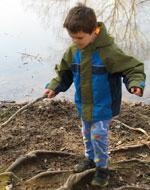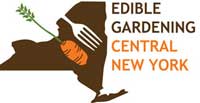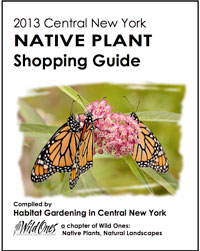Next EGCNY Meeting
Thurs., July 11
6:30 pm
Liverpool Library
| 
Red currants,
currently being harvested
| We'll discuss how our gardens are doing this year: what problems people are having (and their solutions, hopefully), what is ready to eat now, and what we can expect in the next month.
Hearing about fellow gardeners' experiences is always helpful and encouraging.
Edible Gardening CNY meetings are free and open to the public.
Please join us!
|
| Summer Camp at Baltimore Woods |  |
A Baltimore Woods summer tradition for over 25 years! Our week-long day camp adventures promote discovery, physical fitness, problem-solving skills, social interaction, and awareness through direct contact with the natural world. Running weekly from
July 8 - August 30, themed camps include: Nature's Little Explorers (ages 4 and 5) Nature & Art Camp(4th - 6th grade) Voyager Camp(5th-8th grade) Teen Camp(9th-11th grade) Sportman's Education Camp (ages 12-17) Register by calling 673-1350 or visit the website at www.baltimorewoods.org for more details. |
| Our Habitat Garden |  |
Visit Our Habitat Garden website for information on providing habitat, earth-friendly gardening practices, plants, and various creatures here in Central New York.
|
HGCNY Officers
| |
| President:
Janet Allen
Vice-President:
Carol Biesemeyer
Treasurer:
Randi Starmer
Secretary:
Soule Leiter
Membership:
Linda Rossiter
Program Chair:
Carol Biesemeyer
Newsletter Editor:
Janet Allen
Additional Planning Committee Members:
Beth Mitchell
Dave Mitchell
John Allen
Peter Huntington
|
| HGCNY on Facebook |
As as more of us participate on our Facebook page, this will become a useful resource for asking (and answering!) local HGCNYers' questions about habitat gardening. |
|
Join HGCNY!
|  |
Becoming an official member of HGCNY is easy: just join Wild Ones! Basic household membership is $37/year, but there are other options, too. (See membership application or website.)
Wild Ones
P.O. Box 1274
Appleton, Wisconsin 54912-1274
Make checks payable to Wild Ones.
Or telephone toll-free 877-394-9453.
|
|
Our Edible Garden
|  | Visit OurEdibleGarden.org to see an example of a Central New York edible garden, the perfect companion to your habitat garden.
|
| Interested in Edible Gardening? | 
|
If you'd like to get information on Edible Gardening CNY, just email John to find out about edible gardening tours and monthly programs. Free and open to the public! |
|
 | Butterflyweed
(Asclepias tuberosa) |
Milkweeds and monarchs
We had a heartwarming response to our monarch butterfly initiative. So many people wanting milkweeds for monarchs! Unfortunately, we ran out of our 864 milkweeds before we ran out of people wanting to plant them. If you still need milkweeds, check the Native Plant Shopping Guide for vendors selling milkweed, especially those grown from locally collected seeds.
Summer Show Me Help Me Tours
Show Me Help Me tours are a Wild Ones and HGCNY tradition. They're an opportunity to see what people have done with their landscapes as well as an opportunity to share your ideas about some of the things they're wondering about.
Mark the dates for this year's tours:
Sat. 7/20 at 10 am (NOTE CHANGE of date!)
Sat. 7/27 at 9 am
Wed 8/7 at 5:45 pm
The next newsletter will have more details about the type of properties, RSVPs etc.
Annual picnic
Sat. 8/24 at Randi's - Tour in the morning; pot luck picnic at noon. (Details in future newsletter.)
Janet Allen
President, HGCNY
|
|
We've got milkweeds, BUT ...
 | Tall boneset (Eupatorium altissimum) seen in a PA field during last year's migration
|
Now, we're just waiting for monarchs to take advantage of their host plant. As expected from the small size of the overwintering population, sightings have been down -- expected, but still disappointing and worrisome.
If you haven't yet seen a monarch, you're not alone. Although the migration has now reached a northeasternmost location at Old Town, ME -- 3100 miles from their overwintering location! -- many people still are waiting to see their first of the year.
Worse, few butterflies of any kind have been seen.
Seen a monarch?
Journey North wants to know! When you see your first monarch this year, submit your sighting.
And not just milkweeds
Milkweeds are essential food for caterpillars, but the adult butterfly needs nectar -- nectar during its stay in the north and nectar to fuel the final generation's journey to Mexico.
Native plants are the best way to provide this nectar! Here are a few good choices:
* New England aster (Symphyotrichum novae-angliae)
* boneset (Eupatorium spp.)
* joe-pye (previously called Eupatorium, renamed Eutrochium)
* any of the many goldenrods (Solidago spp)
|
|
|
Bees don't see the point of hybrid
flowers
 | |
The same flower as seen by humans (on the left) and by bees (on the right)
Photo: Creative Commons
|
Bees and other pollinators have UV receptors that allow them to see things we humans cannot. The advantage to the plants and their pollinators is that they can see floral guides that point them to the nectar and pollen.
As William Cullina explains:
What we see as a plain white or yellow bloom is revealed to a bee as a complex diagram complete with lines and patches that serve as landing guides to efficiently move bees to nectar and pollen.
Some overly hybridized flowers bred for human purposes and not insects' abilities can be very confusing to six-legged visitors.
I have watched a honeybee stagger aimlessly on a florist's lily. What to me was a lovely pattern of white, yellow and pink spotting on an ivory background was incomprehensible to the bee.
It was as if someone had pulled out all the street signs and rearranged them randomly, and the bee could find no guidance to the nectar in the flower's throat.
~ William Cullina, author and director of the Coastal Maine Botanical Gardens; from his article Flowers with a touch of the blues (the last article on the list)
To see another example of what bees see, move the slider at the top of this photograph - from the BBC News |
|
Featured plant: New Jersey tea, a Revolutionary plant
 | | New Jersey tea (Ceanothus americanus) |
Appropriate for July 4th, it's interesting to note that the colonists used this plant's leaves as a substitute for tea, though the leaves contain no caffeine.
Though we no longer have a grudge against England, we can still appreciate this plant for many other reasons.
First, it's a pretty little plant with white, starry flower clusters. And it's blooming right now, when so many other shrubs have finished blooming.
Second, it's a pollinator favorite, abuzz with bees large and small as well as beneficial wasps.
Third, it's a host plant for quite a few butterflies, including the spring azure, summer azure, and mottled dusky wing butterflies.
Size: 2-3 feet high and wide
Soil: Well drained, preferably dry and sandy
Light: Sun or part sun
William Cullina ranks the ceanothuses among the top ten native shrubs for a butterfly garden. (The New Jersey tea is the only ceanothus along the East coast.)
And The Xerces Society ranks New Jersey tea as one of the plants with special value for bumblebees.
|
|
Learn how "to bird"
 Whether you're a novice or an expert, if you're interested in sharpening your bird identification skills or wondering how to clean your binoculars, the Cornell Lab of Ornithology has a wonderful online resource called Inside Birding, part of their comprehensive All About Birds website. Whether you're a novice or an expert, if you're interested in sharpening your bird identification skills or wondering how to clean your binoculars, the Cornell Lab of Ornithology has a wonderful online resource called Inside Birding, part of their comprehensive All About Birds website.
From the Inside Birding website:
In the Inside Birding videos, hosts Chris Wood and Jessie Barry share all of the tools, tips, and techniques that will allow you to start birding like the pros.
From where and when to find birds, to the clues that will help you identify them, Inside Birding provides the information that you need to make the most of your birding experience. So check out these videos and take your birding to the next level.
|
|
|
Native Plant Shopping Guide
 | | Click image to download the Guide |
Are you looking for native plants in general or a particular native plant?
Chances are, you can find them somewhere in CNY.
Our 2013 Native Plant Shopping Guide shows you where. You're welcome to download it by clicking on the image to the right, OR you can download it from our website homepage (midway down the page). It's free!
As always, we recommend that you call ahead if you're looking for a particular plant. Some less common native plants may be in short supply, and you wouldn't want to waste a trip to find that your plant had sold out. |
|
|